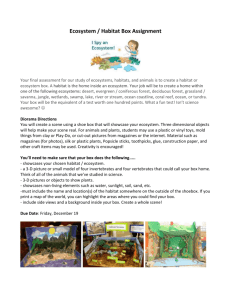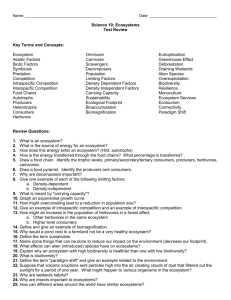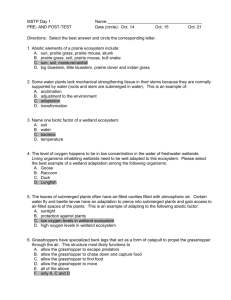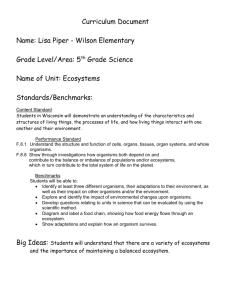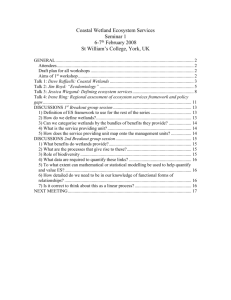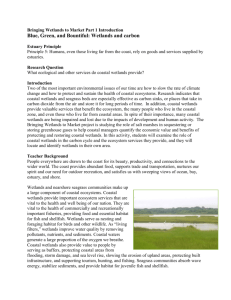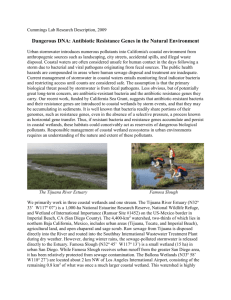Ecosystem Services of Southern California Coastal Wetlands
advertisement
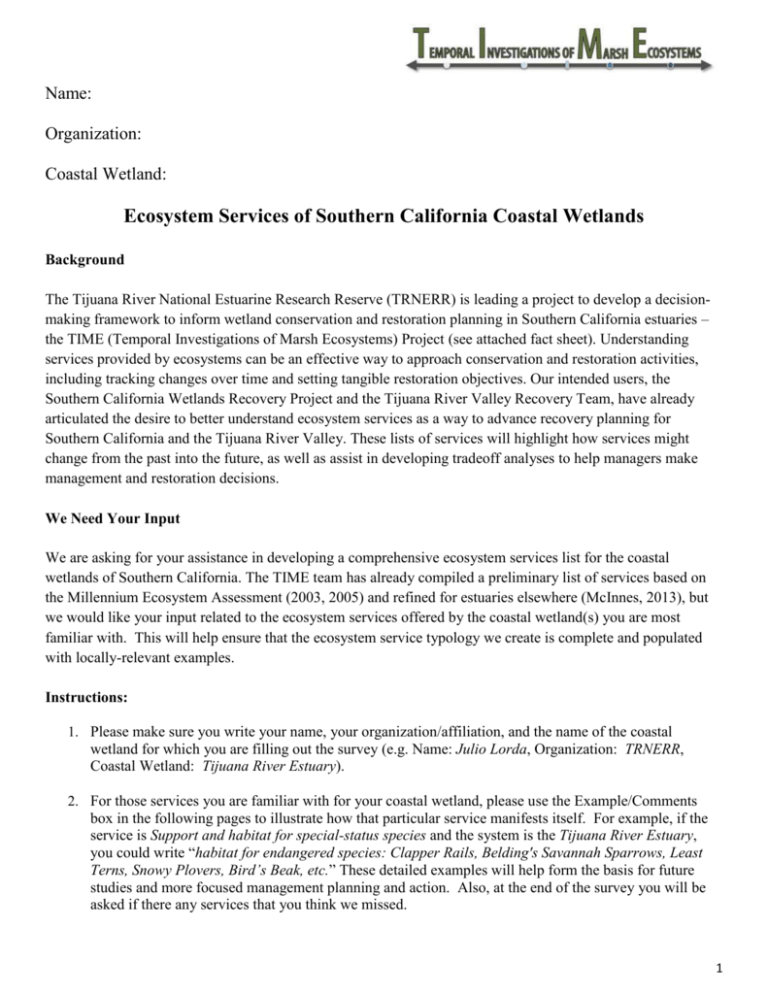
Name: Organization: Coastal Wetland: Ecosystem Services of Southern California Coastal Wetlands Background The Tijuana River National Estuarine Research Reserve (TRNERR) is leading a project to develop a decisionmaking framework to inform wetland conservation and restoration planning in Southern California estuaries – the TIME (Temporal Investigations of Marsh Ecosystems) Project (see attached fact sheet). Understanding services provided by ecosystems can be an effective way to approach conservation and restoration activities, including tracking changes over time and setting tangible restoration objectives. Our intended users, the Southern California Wetlands Recovery Project and the Tijuana River Valley Recovery Team, have already articulated the desire to better understand ecosystem services as a way to advance recovery planning for Southern California and the Tijuana River Valley. These lists of services will highlight how services might change from the past into the future, as well as assist in developing tradeoff analyses to help managers make management and restoration decisions. We Need Your Input We are asking for your assistance in developing a comprehensive ecosystem services list for the coastal wetlands of Southern California. The TIME team has already compiled a preliminary list of services based on the Millennium Ecosystem Assessment (2003, 2005) and refined for estuaries elsewhere (McInnes, 2013), but we would like your input related to the ecosystem services offered by the coastal wetland(s) you are most familiar with. This will help ensure that the ecosystem service typology we create is complete and populated with locally-relevant examples. Instructions: 1. Please make sure you write your name, your organization/affiliation, and the name of the coastal wetland for which you are filling out the survey (e.g. Name: Julio Lorda, Organization: TRNERR, Coastal Wetland: Tijuana River Estuary). 2. For those services you are familiar with for your coastal wetland, please use the Example/Comments box in the following pages to illustrate how that particular service manifests itself. For example, if the service is Support and habitat for special-status species and the system is the Tijuana River Estuary, you could write “habitat for endangered species: Clapper Rails, Belding's Savannah Sparrows, Least Terns, Snowy Plovers, Bird’s Beak, etc.” These detailed examples will help form the basis for future studies and more focused management planning and action. Also, at the end of the survey you will be asked if there any services that you think we missed. 1 Name: Organization: Coastal Wetland: Service Examples / Comments Biodiversity and natural heritage – Non-extractive benefits people obtain from species biodiversity, through ecosystem resilience, habitat for special-status species, etc… Support and habitat for special-status species (endangered or culturally-significant) Support and habitat for a diverse community of native resident species Support and habitat for migrant species Nutrient cycling, water purification, and waste treatment – The ability to filter out and decompose organic wastes and other materials introduced into ecosystems Breakdown and sequestration of anthropogenic nutrients Water purification or contaminant dilution Climate regulation – Influence on climate and atmospheric conditions both locally (e.g., provision of shade and windbreak) and globally (e.g., sequestering greenhouse gases) Local effects on temperature, wind, rainfall, etc… Air quality improvement Carbon storage/sequestration Water supply regulation – Control of the supply of surface- or ground-waters Groundwater recharge Direct water supply for humans 2 Service Direct water supply for livestock and agriculture Examples / Comments Storm and erosion control – Reduction of damage and erosion caused by storms, flooding, or large waves Shoreline, tidal creek, or river bank stabilization Amelioration of flooding Sediment and soil retention (e.g., potential offset to sea-level rise) Soil formation and accumulation of organic matter (e.g., potential offset to sea-level rise) Control of diseases and pests – Control of human pathogens (e.g., cholera), disease vectors, (e.g., mosquitoes), noxious weeds, and crop / livestock pests Control of agricultural or livestock pests Limit pathogens or vectors of human diseases Suppression of noxious weeds Food and raw materials – Products derived from plants, animals, and microbes, materials such as wood, fibers, and fuel, and support for species that promote food production Direct provision of food, or habitat support for edible species Raw materials such as fuel (including biofuels), wood, and fibers Support for pollinators of crops Genetic, biochemical, and ornamental resources – Genes used for animal and plant breeding, biochemicals, natural medicines, pharmaceuticals, and ornamental resources Genetic resources for biotechnology 3 Service Natural medicines and pharmaceuticals Examples / Comments Ornamental resources (shells, drift wood, flowers etc.) Non-Material and Cultural – Non-extractive benefits people obtain through personal enrichment, cognitive development, recreation, and opportunities to experience natural heritage Nature observation, outdoor recreation, and ecotourism Aesthetic values Science and education 4 Please use the table below for any other services that we did not include, but are provided by your system: Service Examples/ Comments References Millenium Ecosystem Assessment, 2005. Ecosystems and Human Well-Being: Wetlands and Water Synthesis. http://www.millenniumassessment.org/documents/document.358.aspx.pdf Millennium Ecosystem Assessment, 2003. Ecosystems and Human Well-being: A Framework for Assessment. Chapter 2: Ecosystems and their Services, 49-70 http://www.unep.org/maweb/documents/document.300.aspx.pdf McInnes, R. J., 2013. Recognizing Ecosystem Services from Wetlands of International Importance: An Example from Sussex, UK. Wetlands 33, 1001–1017 5

